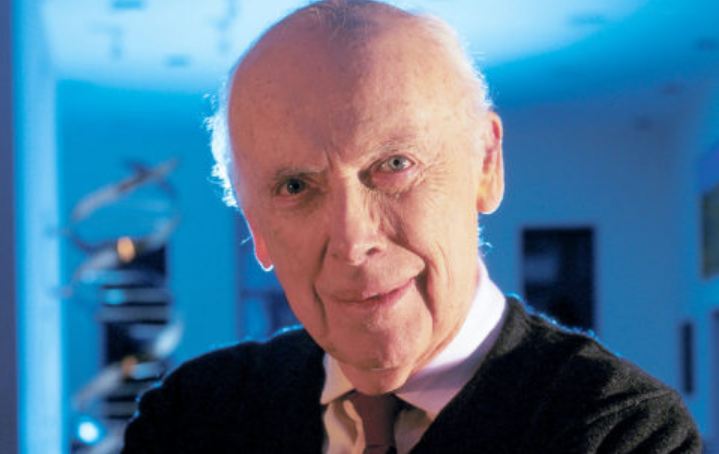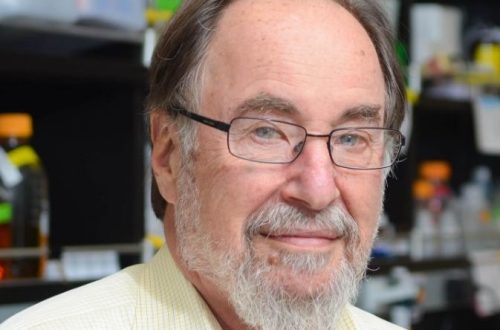
How to Contact James D. Watson: Phone Number, Fanmail Address, Email Address, Whatsapp, House Address

James D. Watson: 8 Ways to Contact Him (Phone Number, Email, House Address, Social media profiles)
James D. Watson: Ways to Contact or Text James D. Watson (Phone Number, Email, Fanmail address, Social profiles) in 2023- Are you looking for James D. Watson’s 2023 Contact details like his Phone number, Email Id, WhatsApp number, or Social media accounts information that you have reached on the perfect page.
James D. Watson Biography and Career:
James D. Watson, along with Francis Crick, was one of the individuals who contributed to the discovery of the double helix structure of DNA. They accomplished this goal because of the prior study by Rosalind Franklin and Maurice Wilkins.
James Watson, the son of American parents of English, Scottish, and Irish heritage, was born in Chicago. His parents were both of American descent. Watson was the younger of his parents’ two children and shared his interest in bird watching with his father, who worked as a tax collector. This was the turning point in his career aspirations. In 1968, he wed Elizabeth Lewis, and the couple went on to have two kids, one of whom would later be diagnosed with schizophrenia. Watson’s interest in the genetics of sickness was piqued when he learned that his son suffered from the illness.
Watson had his early education at Horace Mann Grammar School and continued his education at South Shore High School. He attended the University of Chicago at age 15, eventually earning a degree in biology from that institution. In 1947, Watson started his doctoral studies in zoology at Indiana University. While there, he researched bacteriophages, viruses that replicate by invading bacteria to do so. Watson’s goal was to understand the basis of genetic mutation better. After receiving his doctorate in 1950, Watson continued researching viruses while attending Copenhagen University for a postdoctoral year. During this time, he also began to educate himself in chemistry for the first time.
In 1951, Watson became a Medical Research Council Unit member, working out of the Cavendish Laboratories in Cambridge. At the time, numerous powerful X-ray crystallographic studies were being performed. Almost immediately, he began working with Francis Crick to decipher the structure of DNA. Starting in 1956, he worked in various capacities at Harvard University.
In 1968, he was appointed director of the Cold Spring Harbour Laboratory (CSHL), contributing to the institution’s rise to prominence as a premier center for genetic research. After serving as director of the National Centre for Human Genome Research at the National Institutes of Health from 1988 to 1992, James Watson eventually returned to CSHL, where he worked until his retirement in 2007.
In 1953, Watson and Crick presented their findings that showed that the structure of DNA is a double helix. This is the discovery that is most firmly linked with Watson. This breakthrough opened up a new knowledge of biology and genetics, laying the groundwork for the invention of recombinant DNA, which helped create the new biotechnology sector in the 1970s.
It was awarded a Nobel Prize for this work, along with the creation of Francis Crick and Maurice Wilkins, who were also involved in the research. Under his direction, Cold Spring Harbour Laboratory developed into a preeminent research facility, which not only assisted in elucidating the molecular underpinnings of cancer but also uncovered cancer genes for the first time.
Jim Watson was just 24 years old when he and Francis Crick worked together to determine the DNA structure, sometimes called “the molecule of life.” This was a pivotal moment in the 20th century, providing the answer to a significant mystery in the field of life sciences and paving the way for a revolution in biochemistry. Without exaggeration, nothing in the annals of human history would ever be the same again. Nothing.

During the fall of 1951, Watson went to the Cavendish Laboratory at Cambridge University in search of achievement, recognition, and the love of women. He was cocky, bright, and American, a graduate biologist from the middle of the country who came from a farming family and had aspirations of earning the Nobel Prize.
Francis Crick was a 35-year-old would-be biophysicist who had seen duty as a scientist in World War II. Watson, who was as conceited as he was unknown, worked alongside Crick at the Cavendish. Crick was a guy who was somewhat disregarded since he was an older man. Watson was as arrogant as he was obscure. Watson’s description of his new coworker is brash and insensitive; he calls him “totally unknown” and says that they are “often not appreciated.” The majority of individuals felt that he spoke too much.
However, before long, they were inseparable and began regularly congregating at the Eagle, a well-known bar in Cambridge that was a stone’s throw away from their laboratory. In this room, they would discuss the many prevalent scientific concerns. Both Crick and Watson were aware that the structure of deoxyribonucleic acid (DNA) and its significance in human heredity was the unconquered Everest of modern biochemistry and needed to be solved, and at least ten years had passed since research teams in London, Europe, and California attempted to solve this issue.
A searing image of two young guys taking on the Anglo-American scientific establishment and succeeding against the odds, Watson’s firsthand narrative of their quest is both uncompromisingly honest and incredibly exhilarating. Watson’s tale paints a vivid picture of the two of them. Some of the people who were injured during the events of this narrative afterward noted that Watson’s American brashness translates into the Pepys-like candor, even naivete, of “honest Jim.”
The most incredible thing that can be said about “honest Jim” is that he is nearly as harsh on himself as everyone else. The character of the young scientist shown in “The Double Helix” would pick your intellectual pocket while chatting you up at your laboratory bench and then dash off to chase after another Cambridge au pair lady, or “popsy” as he refers to her in his American slang.
Crick never disagreed with his colleague. Still, he took issue with the reckless candor of Watson’s narrative, which painted a singular, compelling, and partisan image of a scientific society riven with rivalries, hatreds, feuds, and aspirations. Crick never disagreed with his colleague. Peter Medawar, widely regarded as the top scientific writer of the 1960s, called it “a classic” almost immediately.
Crick and Watson began their pursuit of immortality in 1951 and continued it through 1953. They were up against powerful rivals who had several weaknesses. Both Linus Pauling in California and Maurice Wilkins in London had been researching methods to break the code of DNA for several years. They were getting very close to making a discovery. But despite the vast resources at his disposal, Pauling often needed to make better decisions.

Nearer to home, Crick’s buddy Wilkins was embroiled in a dispute with his brilliant x-ray crystallographer, the problematic figure of Dr. Rosalind Franklin. Wilkins and Crick had known each other for many years. Would Crick and Watson, two carpetbaggers from the Cavendish, obtain enough data to begin the sophisticated thought experiment necessary to establish and validate the structure of DNA?
The unavoidable protagonist of The Double Helix, Watson, was invited to one of Franklin’s lectures in London and, while there, had the epiphanic realization that her x-ray crystallography work was the missing piece to the puzzle that was DNA. In retrospect, Franklin was too close to her studies to see the importance of what she had discovered. In addition to this, she was entangled in a toxic work relationship with Wilkins, her supervisor. Despite this, Watson’s portrayal of Franklin, the sad man at the center of this tale, is very disgusting since it is cruel, misogynistic, and flippant.
Subsequently, a full-fledged biography written by Brenda Maddox and titled The Dark Lady of DNA has highlighted the degree to which Franklin, who passed away in 1958 as a result of ovarian cancer, had maybe unknowingly constructed the background of the work that Crick and Watson would develop and complete in such a victorious manner.
Franklin’s death occurred in 1958. In his secret epilogue, Watson admits this, stating that Franklin “definitely [established] the essential helical parameters [of the DNA molecule] and locating the ribonucleic chain halfway out from the central axis” — a significant admission. Watson also recognizes that Franklin was the first to locate the ribonucleic chain halfway out of the central axis.
Crick and Watson started writing the 900-word essay for Nature at the end of March 1953. This article would alter biochemistry for good and add Crick and Watson’s names to the roll call of famous scientists. The paper began, “We wish to suggest a structure for the salt of deoxyribonucleic acid (DNA).” This piece would transform biochemistry for good. This structure has new properties of significant interest to the biological community.” Two English lines have never contained such an exhilarating understatement as these two.
Watson’s research career is light years from the science practiced today, as detailed in The Double Helix, a wide-eyed and frenetic narrative of unheated university quarters, handwritten communication, serendipitous contacts in bars or on the Cambridge train, and unexpected phone calls. It praises contingency, chance, and the non-scientific virtues of pride, secrecy, chauvinism, and low cunning.
It is more personal and unquestionably heroic. It is unrefined, impulsive, and impossible to put down. It has influenced a generation of accessible scientific writing and, perhaps, the popularising work of authors such as Malcolm Gladwell and Michael Lewis. It does this by taking an impossibly complicated topic and providing an account for the average reader.

James D. Watson Profile-
- Famous Name– James D. Watson
- Birth Sign-Aries
- Date of Birth– 6 April 1928
- Birth Place– Chicago, Illinois, United States
- Age – 95 years (As 0f 2023)
- Nickname– James D. Watson
- Parents– Father: James D. Watson, Mother: James D. Watson
- Sibling– Elizabeth Jean Watson
- Height– 1.85 m
- Profession– Biologist
- Twitter Followers: NA
- Total Insta Followers: NA
- Total YouTube Subs: NA
James D. Watson’s Phone Number, Email, Contact Information, House Address, and Social Profiles:

Ways to Contact James D. Watson :
1. Facebook Page: NA
2. YouTube Channel: NA
3. Instagram Profile: MA
4. Twitter: NA
5. Phone number: 931-503-1386
Many phone numbers are leaked on google and the internet in the name of James D. Watson, but upon checking, we found none work. However, when we see the exact number, we will update it here.
6. Fan Mail Address:
James Watson
Cold Spring Harbor Laboratory
1 Bungtown Road
Cold Spring Harbor, NY 11724
USA
7. Email id: NA
8. Website URL: NA
Read Also: How to Contact Brian Cox: Phone Number, Fanmail Address, Email Address, Whatsapp, House Address



